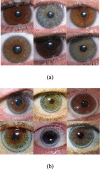A Deep Learning Approach to Automatic Recognition of Arcus Senilis
- PMID: 32802798
- PMCID: PMC7416095
- DOI: 10.31661/jbpe.v0i0.2003-1080
A Deep Learning Approach to Automatic Recognition of Arcus Senilis
Abstract
Background: Arcus Senilis (AS) appears as a white, grey or blue ring or arc in front of the periphery of the iris, and is a symptom of abnormally high cholesterol in patients under 50 years old.
Objective: This work proposes a deep learning approach to automatic recognition of AS in eye images.
Material and methods: In this analytical study, a dataset of 191 eye images (130 normal, 61 with AS) was employed where ¾ of the data were used for training the proposed model and ¼ of the data were used for test, using a 4-fold cross-validation. Due to the limited amount of training data, transfer learning was conducted with AlexNet as the pretrained network.
Results: The proposed model achieved an accuracy of 100% in classifying the eye images into normal and AS categories.
Conclusion: The excellent performance of the proposed model despite limited training set, demonstrate the efficacy of deep transfer learning in AS recognition in eye images. The proposed approach is preferred to previous methods for AS recognition, as it eliminates cumbersome segmentation and feature engineering processes.
Keywords: Arcus Senilis; Classification; Deep Learning; Transfer Learning.
Copyright: © Journal of Biomedical Physics and Engineering.
Conflict of interest statement
Conflict of Interest: None
Figures




References
-
- Ramlee R A, Aziz K A, Ranjit S, Esro M. Automated detecting arcus senilis, symptom for cholesterol presence using iris recognition algorithm. Journal of Telecommunication, Electronic and Computer Engineering (JTEC) 2011;3(2):29–39.
-
- Berggren L. Iridology: A critical reveiw. Acta Ophthalmologica. 1985;63(1):1–8. doi: 10.1111/j.1755-3768.1985.tb05205.x. - DOI
-
- Morrison P J. The iris–a window into the genetics of common and rare eye diseases. The Ulster medical journal. 2010;79(1):3–5. [ PMC Free Article ] - PMC - PubMed
-
- Anjarsari A, Damayanti A, Pratiwi A B, Winarko E. Hybrid radial basis function with firefly algorithm and simulated annealing for detection of high cholesterol through iris images. IOP Conf Ser: Mater Sci Eng; Malang, Indonesia: IOP Publishing Ltd; 2019 . - DOI
-
- Um J Y, An N H, Yang G B, Lee G M, Cho J J, Cho J W, Hwang W J, et al. Novel approach of molecular genetic understanding of iridology: relationship between iris constitution and angiotensin converting enzyme gene polymorphism. The American journal of Chinese medicine. 2005;33(3):501–5. doi: 10.1142/S0192415X05003090. - DOI - PubMed
LinkOut - more resources
Full Text Sources
Medical
Research Materials
